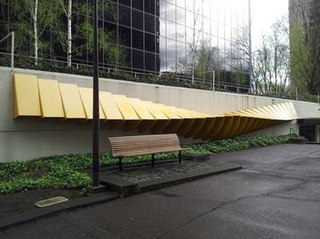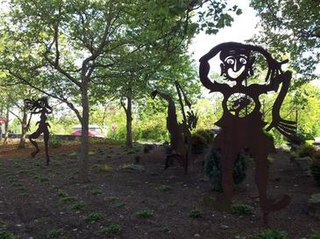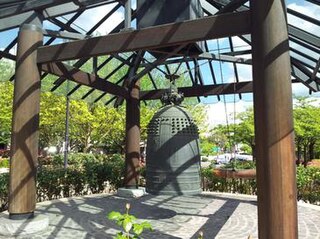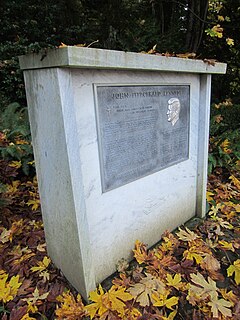The year 1991 in art involved some significant events and new works.

Kvinneakt is an abstract bronze sculpture located on the Transit Mall of downtown Portland, Oregon. Designed and created by Norman J. Taylor between 1973 and 1975, the work was funded by TriMet and the United States Department of Transportation and was installed on the Transit Mall in 1977. The following year Kvinneakt appeared in the "Expose Yourself to Art" poster which featured future Mayor of Portland Bud Clark flashing the sculpture. It remained in place until November 2006 when it was removed temporarily during renovation of the Transit Mall and the installation of the MAX Light Rail on the mall.

Neukom Vivarium is a 2006 mixed media installation by American artist Mark Dion, located at Olympic Sculpture Park in Seattle, Washington, United States. The work features a 60-foot (18 m) Western hemlock that fell outside of Seattle in 1996, acting as a nurse log within an 80-foot (24 m) greenhouse. According to the Seattle Art Museum, which operates the park, the tree "inhabits an art system" consisting of bacteria, fungi, insects, lichen and plants. The installation supplies magnifying glasses to visitors wanting a closer inspection; they are provided field guides in the form of tiles.

The Quest, sometimes referred to as Saturday Night at the Y or Three Groins in a Fountain, is an outdoor marble sculpture and fountain designed by Count Alexander von Svoboda, located in Portland, Oregon in the United States. The sculpture, carved in Italy from a single 200-ton block of white Pentelic marble quarried in Greece, was commissioned by Georgia-Pacific in 1967 and installed in front of the Standard Insurance Center in 1970. It depicts five nude figures, including three females, one male and one child. According to the artist, the subjects represent man's eternal search for brotherhood and enlightenment.

Awning is an outdoor 1976 painted aluminum sculpture by Canadian artist Douglas Senft, located near Southwest 3rd Avenue and Southwest Market Street in downtown Portland, Oregon. The 60-foot (18 m) sculpture was selected and funded by the Portland Development Commission from more than 200 proposals in a request for art intended to "humanize the modern architecture" of the Portland Center. Senft was 26 years old when Awning was installed. It is part of the collection of the Regional Arts & Culture Council. The yellow-colored work is mounted to the side of 200 Market along a pedestrian trail that serves as an extension of Third Avenue.

Three Figures is an outdoor sculpture by American artist Mark Bulwinkle, located at Northeast 13th Avenue and Northeast Holladay Street in Portland, Oregon's Lloyd District. The installation includes three bronze or steel figures, created during 1991–1992, each measuring between 8 feet (2.4 m) and 10 feet (3.0 m) tall. Originally installed at AVIA's corporate headquarters, the figures were donated to the City of Portland and relocated to their current location "to appear to be enjoying the green space". Three Figures is part of the City of Portland and Multnomah County Public Art Collection courtesy of the Regional Arts & Culture Council.

Burls Will Be Burls is an outdoor 2009 bronze sculpture by American artist Bruce Conkle, located in Portland, Oregon.

The Dream, also known as the Dr. Martin Luther King Jr. Memorial Sculpture, is an outdoor bronze sculpture of Martin Luther King Jr. by Michael Florin Dente, located outside the Oregon Convention Center in Portland, Oregon. The 8-foot (2.4 m) memorial statue was dedicated on August 28, 1998, the 35th anniversary of King's "I Have a Dream" speech. It depicts King plus three allegorical sculptures: a man who symbolizes the American worker, a woman who represents immigration, and a young girl shown releasing King's coattail, who represents, according to Dente, the "letting go" that occurs when people sacrifice their time and energy to engage in a struggle. The sculpture is part of the City of Portland and Multnomah County Public Art Collection, courtesy of the Regional Arts & Culture Council.

Liberty Bell refers to one of two replicas in Portland, Oregon, United States, of the original Liberty Bell in Philadelphia. The first replica was purchased in 1962, and installed in the rotunda of City Hall in 1964. On November 21, 1970, it was destroyed in a bomb blast that also damaged the building's east portico. The second replica was installed outside of City Hall soon after the blast with funds from private donations. It was dedicated on November 6, 1975. The bell is listed as a state veterans memorial by the Oregon Department of Veterans' Affairs.

Farewell to Orpheus is an outdoor 1968–1973 bronze sculpture and fountain by Frederic Littman, installed at the Portland State University campus in Portland, Oregon, United States.

Bell Circles II, also known as Sapporo Friendship Bell and part of the sound installation by composer Robert Coburn called Bell and Wind Environment, is an outdoor bronze bell by an unknown Japanese artist, housed in a brick and granite pagoda outside the Oregon Convention Center in Portland, Oregon, United States. The temple bell was presented by the people of Portland's sister city Sapporo, Japan and dedicated in February 1990. It cost $59,000 and was funded through the Convention Center's One Percent for Art program and by private donors. According to the Smithsonian Institution, some residents raised concerns about the bell's religious symbolism and its placement outside a public building. It was surveyed and considered "treatment needed" by the Smithsonian's "Save Outdoor Sculpture!" program in July 1993.

Capitalism is a 1991 outdoor marble and concrete sculpture and fountain by Larry Kirkland, located in northeast Portland, Oregon, United States.

Leland I, sometimes stylized as Leland 1 or Leland #1, is an outdoor 1975 sculpture by Lee Kelly and Bonnie Bronson, installed in Portland, Oregon, United States.

Korean Temple Bell, part of the sound installation by composer Robert Coburn called Bell and Wind Environment, is an outdoor bronze bell by an unknown Korean artist, housed in a brick and granite pagoda outside the Oregon Convention Center in Portland, Oregon, United States.

The John Fitzgerald Kennedy Memorial, also known as The Grotto: John Fitzgerald Kennedy Memorial, is an outdoor 1965 large bas-relief sculpture and memorial to John F. Kennedy by an unknown artist, installed outside The Grotto in Portland, Oregon, United States.
Silicon Forest, sometimes referred to as The Silicon Forest, is an outdoor 2003 sculpture by Brian Borrello, installed near the Interstate/Rose Quarter station in Portland, Oregon's Lloyd District, in the United States.
The Seattle George Monument, also known as Seattle, Washington Monument, is an outdoor 1989 sculpture by Buster Simpson, installed outside the Washington State Convention Center, north of 7th Avenue between Union and Pike Streets, in Seattle, Washington, in the United States. The kinetic sculpture, which is made from aluminum, steel, painted metal, wire, English ivy, concrete, and mylar sheets, depicts Chief Seattle and George Washington. It was surveyed and deemed "treatment needed" by the Smithsonian Institution's "Save Outdoor Sculpture!" program in October 1994. The sculpture was designed to resemble the highway shields used by Washington's state highway system.

Salmon Cycle Marker is a 2005 sculpture by Ken MacKintosh and Lillian Pitt, installed outside Portland State University's Native American Student and Community Center, in the U.S. state of Oregon.
The Ainu and Native American power boards are two hand carved wooden planks by members of Ainu and Chinook tribes, installed outside the Oregon Convention Center in Portland, Oregon. The pieces were commissioned for Forest of Dreams and exhibited at the Portland Japanese Garden before being erected in the Lloyd Center in 2019.
















